Lyxor ETF Basic Resources - BRE - 22/01/19
Short Term strategy: Positive (70%) / Trend +
Long Term strategy: Positive (60%) / Trend +
Characteristics of the ETF
The ETF Lyxor BRE (Basic Resources UCITS Europe) created in 08/2006 is listed in Euro on Euronext and seeks to replicate the index STOXX600 Basic Resources Europe composed of 20 European stocks of which about 2/3 are English, which implies a significant risk related to the Euro – Sterling evolution which can be quite volatile in this period of Brexit.
The costs of this ETF are 0.3% and the AUM of approximately 234M€. Replication is indirect (via Swap) and there is a dividend capitalization policy. This ETF is eligible for PEA.
Alternative ETF: EXV6 (iShares in Euro)
Latest developments
BRE was up 22.3% in 2017, well above Stoxx600NR (10.6%), reflecting the rebound in commodities, which tended to stabilize or fall in 2018. But trade tensions between the US and China caused a sharp correction in 2018 (-12.8%) slightly higher than that of Stoxx600 (-10.7%). The rebound has been strong since the beginning of the year (+ 7.6% versus + 5.5% for the Stoxx600 NR in 2019) and fueled by the hopes of a deal between China and the US, as well as more accommodating central bank policies.
The sector has a satisfactory relative behavior, despite its exposure to the global cycle, which results from good discipline on cash flows and capacity management that have not given rise to the exuberance known in the 2010's. There is therefore no real overcapacity, and the significant productivity gains made in recent years are reflected in the margins and cash flows of the major mining companies.
The sector is therefore solid and can cope with a moderate slowdown in global demand forecast in 2019.
Index & components
This is a fairly narrow index composed of 19 major mining companies, mostly listed in the UK.
The 3 largest mining companies, Rio Tinto, BHP Billington and Glencore account for c. 53% of the weighting of the index and are quoted in £ on the LSE. They are diversified mining companies (iron ore, copper, coal ...) with market capitalizations between € 50 and € 75bn. These companies are listed on European markets (especially London) but mining operations are most often located in Africa, Australia or the Americas.
After five difficult years (2011-2015), commodity prices started to recover in 2016, due to Chinese capacity reduction announcements (mainly steel and aluminum) and a surge of optimism around the world. Donald Trump's victory in the US presidential elections, tied to the promise of a major infrastructure program, as key triggers. The prices evolution rather favorable in 2017 for a certain number of metals (aluminum, copper, Nickel, Palladium ...) because of a reduction of the overcapacities coming from China, and growth themes like the electric car and renewable energies. The current demand is also largely due to China's support for its economy (real estate / construction in particular) and can therefore seem a bit fragile.
Diversification is at the heart of the strategy of the major mining companies who wish rather to develop capacities in the sectors of the future (Aluminum, Copper ...) and to reduce them in troubled sectors (Coal ...). The sector depends on two main factors, namely demand, especially for infrastructure and the industrial sector (construction and automotive), mainly from China and the US, but also from Europe and major emerging countries such as India, but especially of the supply side so far plethoric. The scenario of a drastic decline in Chinese capacity does not seem to be on the agenda, especially in iron ore, but the introduction of the US import tax on certain metals (aluminum) could incite China to more discipline on its supply policy.
BRE remains a rather volatile medium, which is very sensitive to variations in demand but also to supply adjustments.
Monthly data
The monthly chart shows a significant correction that has developed throughout the second half of 2018 and brings a strong rebound in January in the form of bullish engulfing, which if confirmed at the end of the month will signal the end of the current correction and the start of a new surge over a period of several months.
Weekly data
On the weekly chart, we can observe a trend reversal in progress over the medium term horizon. The prices have just gone over the EMA26 and the MACD has turned upwards. The bearish line, whose origin dates from June 2018, has been invalidated, which represents a further confirmation of the current trend reversal. The objective of this reversal is the return to the 2018 highs.
Theme
BRE is a UCITS ETF, listed in EUR, which seeks to replicate the STOXX Europe 600 Basic Resources Net Return EUR index (19 european companies)
Characteristics
| Inception date | 25/08/2006 |
| Expense ratio | 0,3% |
| Benchmark | Stoxx600 Basic Resources Net Return |
| Issuer | Lyxor |
| Ticker | BRE |
| ISIN | LU1834983550 |
| UCITS | Yes |
| EU-SD Status | Out of scope |
| Currency | € |
| Exchange | Euronext |
| Assets Under Management | 234 M€ |
| Replication method | Indirect (via a swap) |
| Dividend | Capitalization |
| PEA (France) | Yes |
| SRD (France) | Yes |
| Currency risk | Yes |
| Number of Holdings | 19 |
| Risk | 4/5 |
Country Breakdown
| United Kingdom | 36% |
| Australia | 15% |
| Switzerland | 15% |
| Finland | 10% |
| Luxembourg | 8% |
| Sweden | 5% |
| Norway | 3% |
| Others | 8% |
Top Ten Holdings
| Materials | 95% |
| Energy | 3% |
| Consumer Staples | 2% |
Top Ten Holdings
| Rio Tinto | 23% |
| BHP Group | 15% |
| Glencore Xstrata | 15% |
| Anglo American | 9% |
| ArcelorMittal | 6% |
| UPM-Kymmene | 6% |
| Mondi | 4% |
| Stora Enso | 3% |
| Boliden | 3% |
| Norsk Hydro | 3% |


